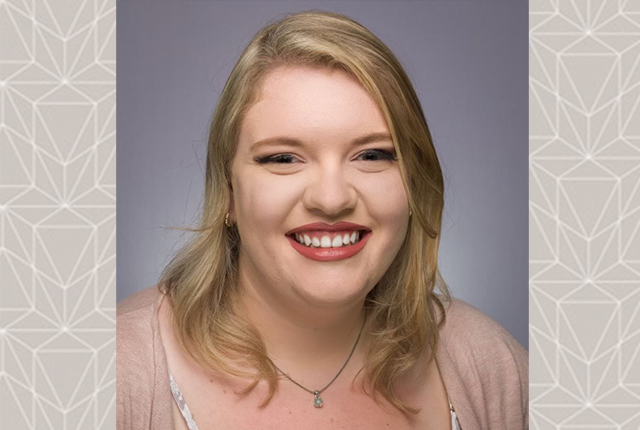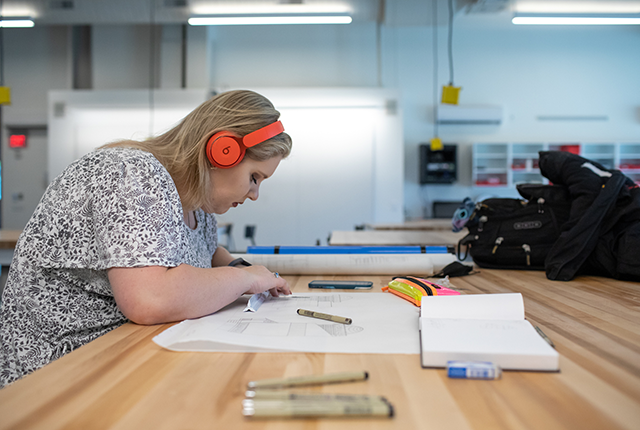
Cari Marchak ’24, a civil engineering and architectural design + technology double major, knew from an early age she wanted to explore a career that would impact her environment and the world around her.
In high school, she fell in love with the areas of civil engineering and architecture after taking classes related to the topics. Specifically, Marchak took three years of computer-aided design and a year of architecture courses. It was here at UHart where she discovered the opportunity to study both programs in just five years and earn two bachelors of science degrees. This will allow Marchak to stand out as a candidate for prospective careers in time for graduation.
Marchak says learning about both of these areas at the same time is special in the fact that these fields go hand-in-hand together in the real world, and so do the programs at the University. “During my first year of architecture classes, I was taught how to properly set up an architectural drawing sheet using my scales with paper and pencil at my desk, while learning how to study a form in certain lighting and how it incorporated the use of linework,” Marchak says. “It was there where I also learned how to make my own model of my project using the fabrication and woodshop in our studio as well.”
Cari Marchak ’24, civil engineering and architectural design + technologyUHart gives you more flexibility and options compared to many other schools. I am grateful for the opportunity to pursue degrees in two relative fields through this unique dual program and make the most of my college experience here.

As her semesters progressed, Marchak says she has learned how to further develop some of her original ideas from paper and pencil into a form on computer software programs. In her architecture classes over the years, she has studied many architectural precedents in history. “We are taught to draw inspiration from the past and build on upon the ideas of different works and pieces that we have found inspiring over the years,” Marchak says. “With the help and guidance of my professors, I have designed many of my own pieces over the years that involve inspiration from the past, but also incorporate my own ideas for architecture that I have developed over the years.”
Marchak credits various faculty she has had for playing a part in her journey and success, including Takafumi Asaki, Dan Davis, Jim Fuller, Saleh Keshawarz, and Antonia Marie Ciaverella. These faculty have taught her since her first year and have supported and guided her in many ways. She also is grateful to the staff at UHart’s Women's Advancement Initiative Office (LEAD) for inspiring her as they continue the legacy of the Hartford College for Women.
As for the civil engineering side of her dual degree, Marchak emphasizes how well her civil engineering classes complement what she is learning in architecture. In particular, she discovers this even more as she learns how to study the topographical features around her and how various materials react to certain forces. “This allows me to be able to program, draw and construct three-dimensional models in my transportation, structural analysis, or surveying projects that I am working on,” Marchak says. “I also have taken classes where I studied a wide variety of materials: varying from woods, to metals, to even concrete, to learn about their internal properties and how they react under different types of force so they can be used in the construction process. After I learn how the material reacts under pressure, and I take into factor the environment around me, I then can construct my structural forms to then later present my ideas to industry professionals.”
By having both expertise levels, Marchak will not only have more knowledge and understanding of both parts in the design process from both the architect as well as the engineering standpoint, but also the ability to succeed in more than just one profession after she graduates.
Along with the offerings in the dual program, another opportunity UHart students get to truly picture themselves working in specific fields is through research opportunities and internships. Marchak was eager to gain such valuable experience in the field when she landed an internship with water resource engineering firm Tata & Howard, Inc. over the summer of 2021. The firm specializes in water, wastewater, and stormwater resources. Through her internship, she worked as a draftsman alongside their senior project engineers. “I assisted in the drawings for projects that were in various stages of their design: design stage, preliminary reviews, final documentation for construction, and even as-builts of buildings that were already constructed,” Marchak says. “I learned about the process of the project from start to finish and how different aspects work together.”
Marchak was proud to have put together useful operation and maintenance manuals during her internship to help construct and maintain pump stations as well. There were times as well where she had to call many companies to get comparison prices on parts that were either needed or desired for a project. This allowed her to practice her professional decorum and converse with companies outside of the one she was working with. “I learned a considerable amount during my internship at Tata and Howard and was very fortunate to work alongside the lead engineers all summer on various projects.”
Marchak credits her education and experience at UHart for preparing her for this role in multiple ways. Specifically, she took advantage of networking practice and resume bootcamps throughout the year to not only receive professional feedback on her resume, but also practical experience presenting herself as a professional and sharing her knowledge and career interests in an impactful way.
“UHart strives to shape us into strong professionals and prepare all students for the workforce in every way they can through different networking opportunities, career development and practice, and support to attend professional conferences related to our field or affiliations.”
Earlier this fall, Marchak and nearly twenty other students in the Society of Women Engineers (SWE) UHart chapter experienced just that when they found support from University members to attend the organization’s professional development conference. There, she was able to expand her knowledge and participate in various networking opportunities meeting inspiring female professionals in the industry. Marchak serves as the vice president UHart’s SWE chapter. She also serves as a member of UHart’s Women's Advancement Initiative, a CETA Leadership Student Ambassador, and an office assistant for the NASA Connecticut Space Grant Consortium located at UHart.
When asked what advice she would pass on to incoming students, Marchak says to be confident in your ability to “do it all,” like balancing school, family, and extracurricular activities. “You just have to remain focused on your end goal, but also know how to have fun and enjoy your college experience.”